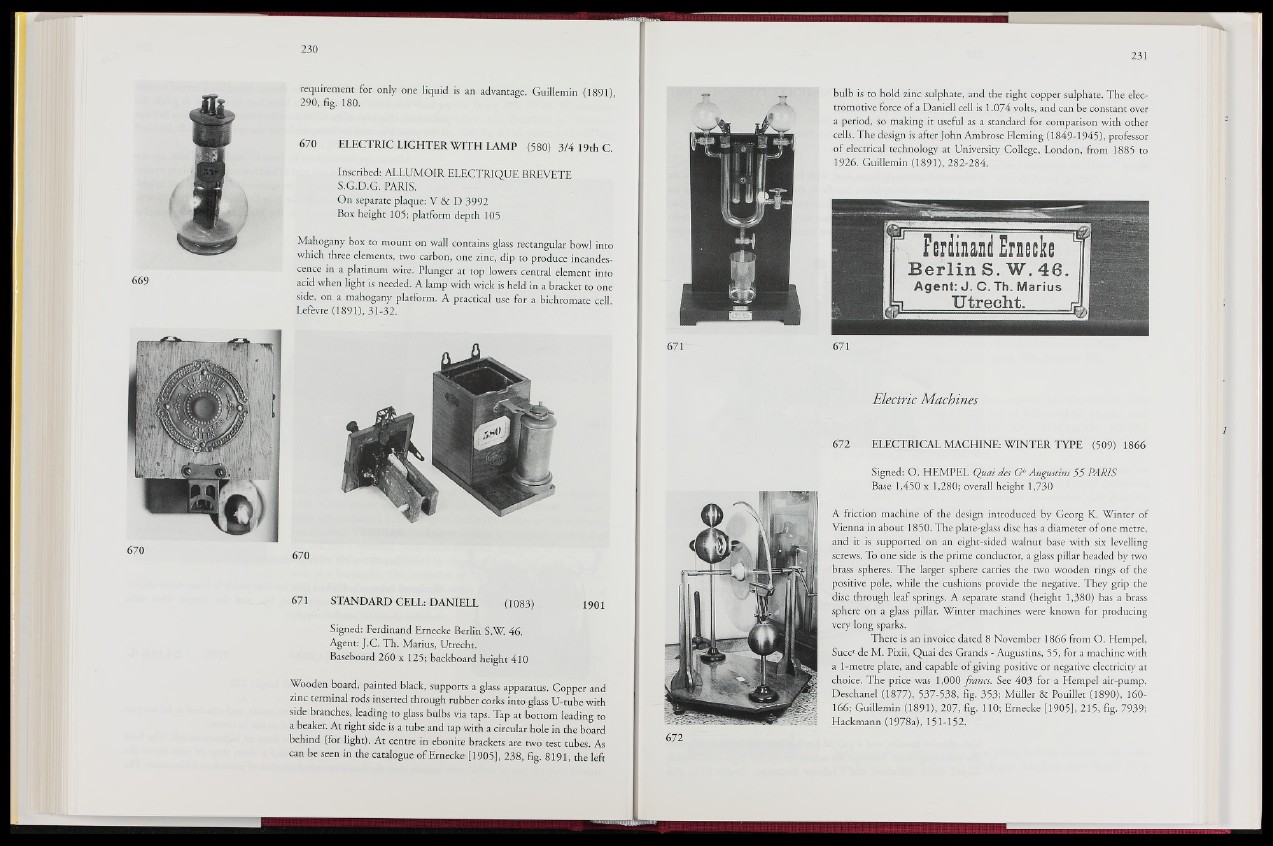
requirement for only one liquid is an advantage. Guillemin (1891)
290, fig. 180.
670 ELECTRIC LIGHTER WITH LAMP .. (580) 3/4 19th C.
Inscribed: ALLUMOIR ELECTRIQUE BREVETE
S.G.D.G. PARIS.
On separate plaque: V & D 3992
Box height 105; platform depth 105
Mahogany box to mount on wall contains glass rectangular bowl into
which three elements, two carbon, one zinc, dip to produce incandescence
in a platinum wire. Plunger at top lowers central element into
acid when light is needed. A lamp with wick is held in a bracket to one
side, on a mahogany platform. A practical use for a bichromate cell.
Leftvre (1891), 31-32.
670
671 STANDARD CELL: DANIELL (1 0 8 § ||: 1901
Signed: Ferdinand Ernecke Berlin S.W. 46.
Agent: J.C. Th. Marius, Utrecht.
Baseboard 260 x 125; backboard height 410
Wooden board, painted black, supports a glass apparatus. Copper and
zinc terminal rods inserted through rubber corks into glass U-tube with
side branches, leading to glass bulbs via taps. Tap at bottom leading to
a beaker. At right side is a tube and tap with a circular hole in the board
behind (for light). At centre in ebonite brackets are two test tubes. As
can be seen in the catalogue of Ernecke [1905], 238, fig. 8191, the left
bulb is to hold zinc sulphate, and the right copper sulphate. The electromotive
force of a Danie|l'ceJ|is 1.074 volts, and can be constant over
a period, so making it useful as a standard for comparison with other
cells. The design is after John Ambrose Fleming (1849-1945), professor
of electrical technology at University College, London, from 1885 to
1926. Guillemin (189® 282-284. ~
671
Electric Machines
672 ELECTRICAL MACHINE: WINTER TYPE :-;|509) 1866
Signed: O. 'HEMPEL Quai des G* Augustins 55 PARIS
Base 1,450 x 1,280; overall height 1,730
A friction machine of the design introduced by Georg K. Winter of
Vienna in about 1850. The plate-glass disc has a diameter of one metre,
and it is supported on an eight-sided walnut base with six levelling
screws, To one side is the prime conductor, a glass pillar headed by two
brass spheres. The larger sphere carries the two wooden rings of the
positive pole, while the cushions provide the negative. They grip the
disc through leaf springs. A separate stand (height 1,380) has a brass
sphere on a glass pillar. Winter machines were known for producing
very long sparks.
There is an invoice dated 8 November 1866 from O. Hempel,
Succr de M. Pixii, Quai des Grands - Augustins, 55, for a machine with
a 1-metre plate, and capable of giving positive or negative electricity at
choice. The price was 1,000 francs. See 403 for a Hempel air-pump.
Deschanel (1877), 537-538, fig. 353; Müller & Pouillet (1890), 160-
166; Guillemin (1891), 207, fig. 110; Ernecke [1905], 215, fig. 7939;
Hackmann (1978a), 151-152.